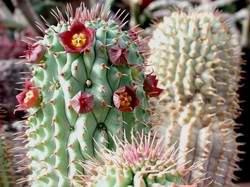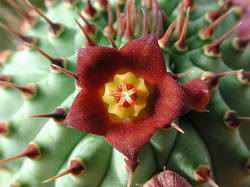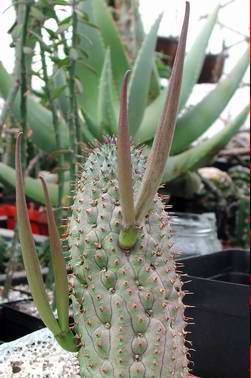Hoodia officinalis subsp. officinalis (N. E.
Brown)
Plowes
(officinalis
= medicinal)
Hoodia officinalis (N. E. Br.) Plowes,
Asklepios 56: 9. 1992
|
|
published in |
|
"Cacti and other Succulents" (KUAS, German original title "Kakteen und andere Sukkulenten) 54 (7) 2003: XXVII-XXVIII |
|
|
Ill. 1: Hoodia officinalis in cultivation (Nauchos, Namibia). |
|
by Ulrich Tränkle and Friederike Hübner 1. First DescriptionTrichocaulon officinale N. E. Brown, Bull. Misc. Inform.
1895: 264. 1895 2. SynonymeTrichocaulon pubiflorum Dinter, Repert. Spec. Nov. Regni Veg. 30: 192. 1932 Trichocaulon rusticum N. E. Brown, Fl. Cape 4 (1): 891. 1909 |
|
|
Ill. 2: Hoodia officinalis close-up.
Ill. 3: Young fruits (handpollination). |
|
3. DescriptionPlant: small shrub up to 30 by 50 cm tall, frequently smaller, branching out from the base, stems grey-green and erect, up to 50 cm tall and 3.5 to 6.5 cm wide. Rows: tubercles set up in rows of 17-22, each ending in a dark brown 6 mm long spine. Flowers: appearing in groups of 1 to 3, predominantly in the upper part of the stems. Pedicel: < 1 mm. Sepals: between 2.5 and 3.5 mm long, smooth, oval-lanceolate, acuminate. Corolla: 1.0 to 1.4 cm in diameter, flat or slightly bell-shaped with a wide plate-shaped tube, its outside hairless and smooth, its inside covered with papillae ending in tiny hairs. The inside is of reddish to yellow-brown colour, lighter in the centre, the outside is greenish with brownish stripes, between 3 and 5 mm long Corollalobes of oval to triangular form, acuminate, outspread with tips bending over backwards, and between 3.5 and 5.5 mm wide at the base. Corona: outer corona predominantly yellow, sometimes with subtle red dots, inner corona brownish, 4 mm in diameter, between 1.5 and 2 mm high, in most cases pubescent. The outer corona forms a pouch between outer and inner corona, parting down close to the base in two erect, obtuse little coadunate dents, not higher than the inner corona. Inner corona smaller than 0.5 mm, oblate, incumbent on the anthers and smaller than these, dorsal little dent connated with the outer corona. Polliniae: reddish-brown. Fruits: follicles, between 115 and 125 mm long; between 164 and 292 seed per pair.
Description
according to Bruyns, P. V. (1993): A
revision of Hoodia and Lavrania (Asclepiadaceae - Stapeliae). Bot. Jahrb. Syst. 115(2): 145‑270
ergänzt um die Fruchtmerkmale. 3. Distributional RangeFrom south of Windhoek (Namibia) all through southern Namibia and eastwards up to Orange Free State near Jacobsdal (South Africa). The plant can neither be found in the south-western winter rainfall region in Namibia nor in parts of the eastern Kalahari. This kind of Hoodia is the one with the widest occurrence. 4. CultivationJust as H. pedicellata. H. officinalis is very sensitive to accumulated heat and full sunshine. The shoot apexes get scorched and dry up. Through the years these shoot apexes continue to die back more and more, thus increasing the risk of rot and decay. Grafting has proved successful on Ceropegia woodi. After half a year the grafted area needs to be covered by 0.5 to 1 cm of for instance fine Quarzkies, as this enhances the growing of roots in the graft. Cuttings only grow roots if they are cut off near the base. The roots will then appear on the sides between the ribs . 5. CommentsBesides Hoodia officinalis there also is Hoodia officinalis subsp. Delaetiana (Dinter) Bruyns. This subspecies grows taller, the spines are up to 1.2 cm longs and the flower reaches a diameter of 1.4 to 2 cm. |
|
|
Ill. 4: Hoodia officinalis subsp. delaetianum, distributed only in a small area. |
|
H. officinalis is rare in collections, the subspecies delaetiana even more so. Seed or even plant specimens are almost unobtainable. Hand-pollination is very difficult and only successful if a certain narrow angle between pollinarium and feeding duct is maintained.Spontaneous frutification has not been noted, neither have hybrids occurred. If the weather is favourable, H. officinalis flowers twice in early summer and in late autumn without any difficulty, but rarely in abundance. The small flowers emit only a very weak kind of unpleasant odour. H. officinalis used to be deployed as a medical plant in order to treat haemorrhoids. Bruyn's revision of the species Hoodia and Varania (1993) moved H. pedicellata from Trichocaulon to Hoodia sect. Trichocaulon.
|



